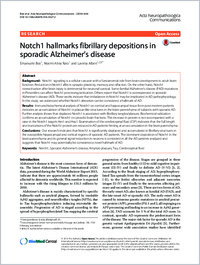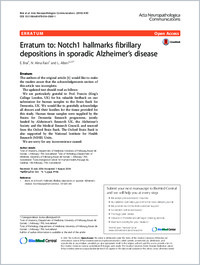Notch1 hallmarks fibrillary depositions in sporadic Alzheimer’s disease
- Brai, Emanuele Unit of Anatomy, Department of Medicine, University of Fribourg, Switzerland
- Raio, Noemi Alina Unit of Anatomy, Department of Medicine, University of Fribourg, Switzerland
- Alberi, Lavinia Unit of Anatomy, Department of Medicine, University of Fribourg, Switzerland
-
01.07.2016
Published in:
- Acta Neuropathologica Communications. - 2016, vol. 4, p. 64
English
Background: Notch1 signaling is a cellular cascade with a fundamental role from brain development to adult brain function. Reduction in Notch1 affects synaptic plasticity, memory and olfaction. On the other hand, Notch1 overactivation after brain injury is detrimental for neuronal survival. Some familial Alzheimer’s disease (FAD) mutations in Presenilins can affect Notch1 processing/activation. Others report that Notch1 is overexpressed in sporadic Alzheimer’s disease (AD). These works indicate that imbalances in Notch1 may be implicated in AD pathophysiology. In this study, we addressed whether Notch1 alteration can be considered a hallmark of AD.Results: Immunohistochemical analysis of Notch1 on cortical and hippocampal tissue from post-mortem patients indicates an accumulation of Notch1 in plaque-like structures in the brain parenchyma of subjects with sporadic AD. Further analysis shows that displaced Notch1 is associated with fibrillary tangles/plaques. Biochemical validation confirms an accumulation of Notch1 in cytosolic brain fractions. This increase in protein is not accompanied with a raise in the Notch1 targets Hes1 and Hey1. Examination of the cerebrospinal fluid (CSF) indicates that the full length and truncations of the Notch1 protein are reduced in AD patients hinting at an accumulation in the brain parenchyma.Conclusions: Our research indicates that Notch1 is significantly displaced and accumulated in fibrillary structures in the susceptible hippocampal and cortical regions of sporadic AD patients. The dominant deposition of Notch1 in the brain parenchyma and its general signal reduction in neurons is consistent in all the AD patients analyzed and suggests that Notch1 may potentially be considered a novel hallmark of AD.
- Faculty
- Faculté des sciences et de médecine
- Department
- Médecine 3ème année
- Language
-
- English
- Classification
- Biological sciences
- License
- License undefined
- Identifiers
-
- RERO DOC 261226
- DOI 10.1186/s40478-016-0327-2
- Persistent URL
- https://folia.unifr.ch/unifr/documents/304948
Other files
Statistics
Document views: 74
File downloads:
- alb_nhf.pdf: 168
- alb_nhf_err.pdf: 121

